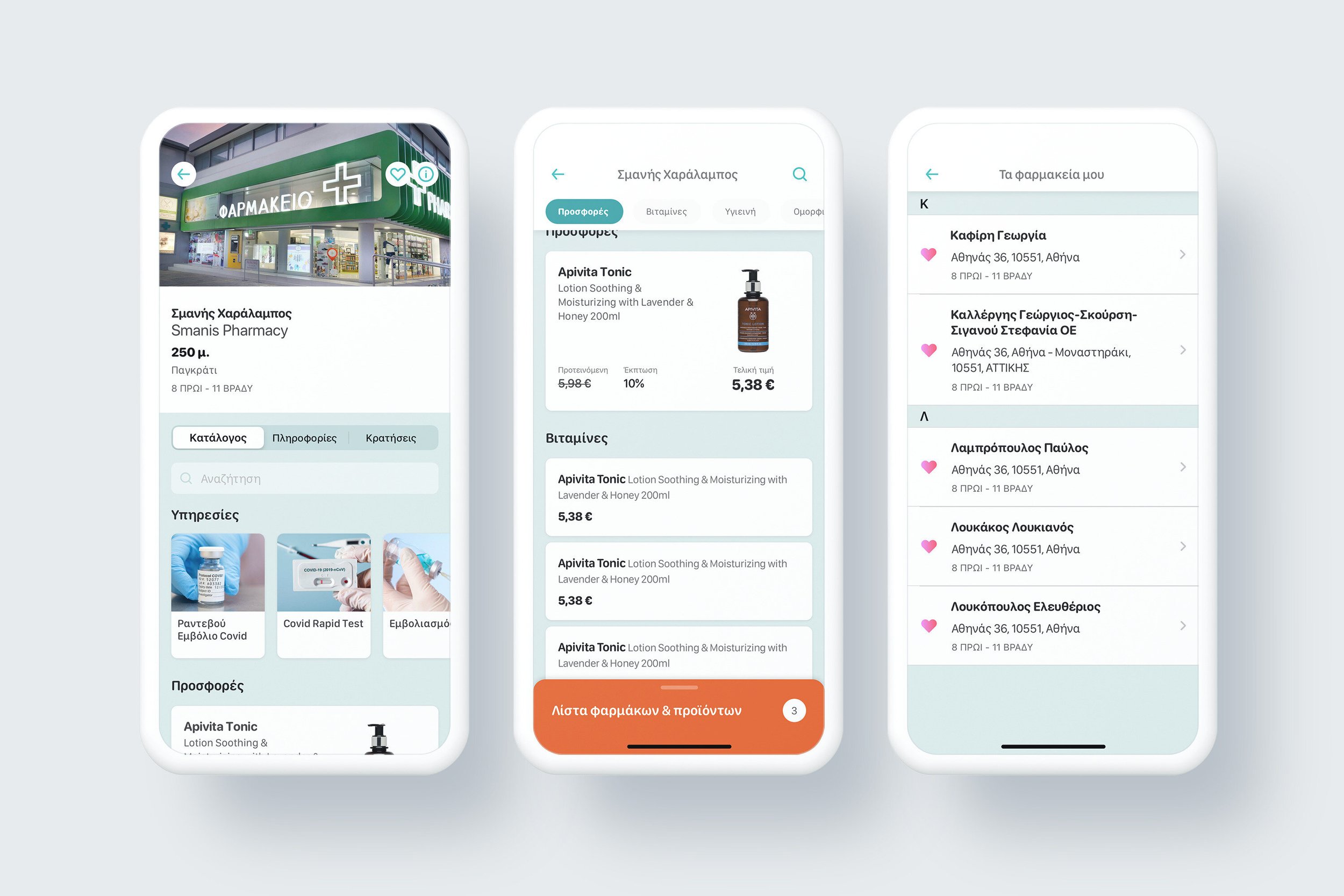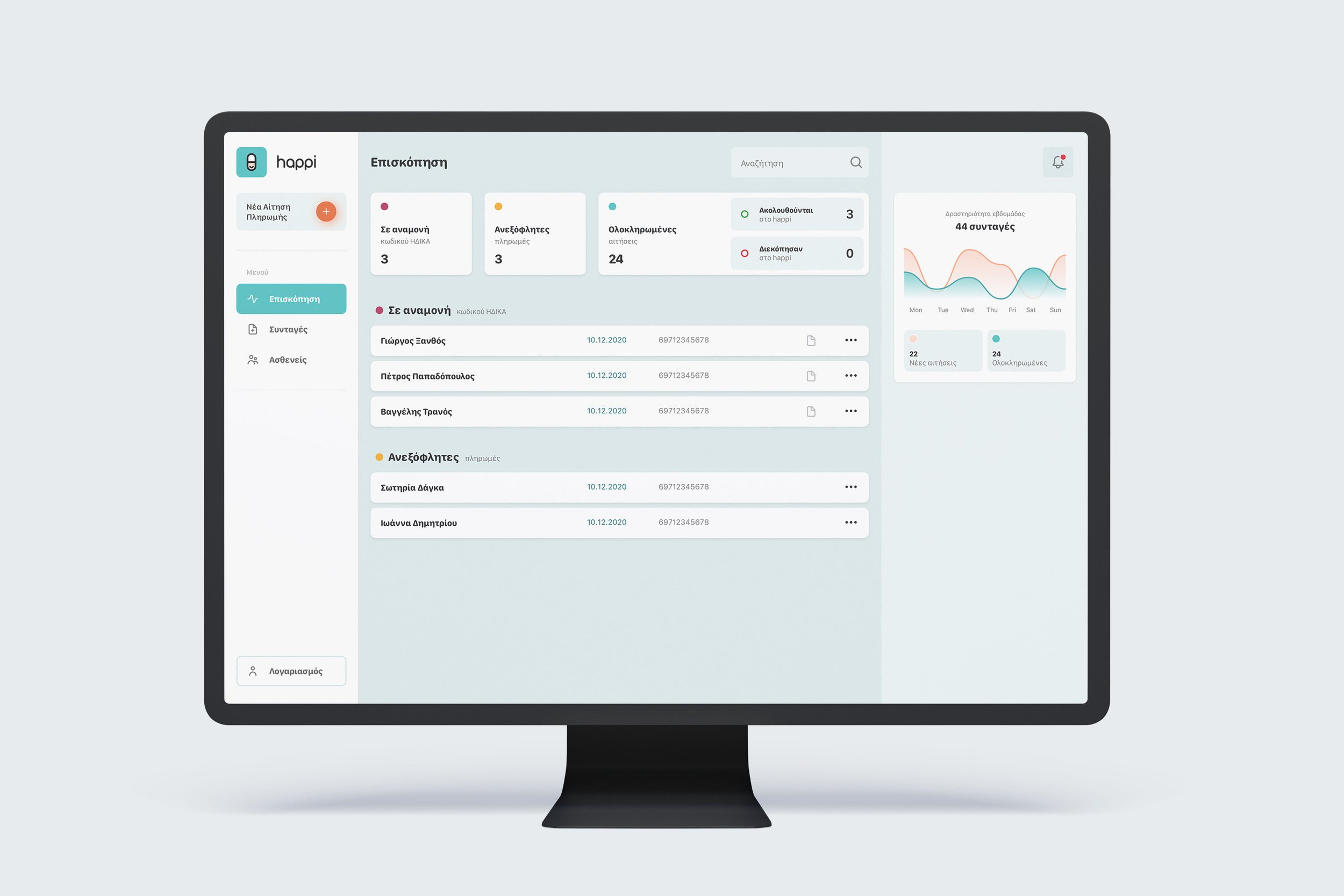Happi
Happi is a startup that aims to help patients search for a doctor for a prescription, look for their medicines at the nearest pharmacy, carry out their prescriptions without shortages, and always remember to take the right pill on the right time. Also, they provide doctors and pharmacies with web apps that complete the best online experience for health and medicines in Greece.
Happi

This case Study is under development
The healthcare industry has been a target for disruption for several years, with various startups entering the market with innovative solutions to some of the industry's most pressing problems. This case study highlights the design process for a startup in the health industry that aimed to disrupt the industry in Greece. The startup developed a mobile app for patients, a web app for doctors, and a web app for pharmacies. The main objective was to connect patients with doctors who can provide remote pill prescriptions and then the best pharmacy to deliver their order. The patient app included additional tools to help patients learn more about their pills and to remind them when to take their dosage. This case study discusses the design process, the outcomes, and the impact of the startup's solution on the health industry in Greece.
Introduction

The design process began with extensive research on the healthcare industry in Greece and user interviews. The research aimed to understand the pain points of patients, doctors, and pharmacies and identify the main problem areas that the startup could focus on. We reviewed existing research on the healthcare industry, which revealed the challenges patients face in accessing healthcare services, particularly in remote areas. Additionally, there were challenges in finding the right doctor or pharmacy to provide the correct medication or treatment. These challenges lead to several patients not receiving the medical attention they needed.
We conducted user interviews with a diverse group of people, including patients, doctors, and pharmacies. The interviews aimed to understand the pain points that each of these groups was experiencing and how the startup could address these challenges. The team used a variety of techniques to collect data, including surveys, one-on-one interviews, and focus groups. The team analysed the data and developed personas to represent different user groups and their pain points.
The main research audiences were: Patients and their family and friends, Doctors, Pharmacies, Medical Companies and the Government.
Research and User Interviews

With the insights gained from user research, the team developed multiple prototypes for each app and tested them with potential users. The feedback received was used to refine the design and functionality of each app. The patient app was developed with features that allowed patients to search for doctors, book appointments, and receive remote pill prescriptions. The app included additional tools to help patients learn more about their pills and to remind them when to take their dosage.
The web app for doctors was developed with features that allowed doctors to manage their appointments, view their patients' medical history, and provide remote pill prescriptions. The app included features that ensured doctors could provide their services quickly and efficiently while maintaining the privacy of their patients.
The web app for pharmacies was developed with features that allowed pharmacies to manage their orders and delivery processes. The app included features that ensured pharmacies could provide a better customer experience by making the order process more straightforward.
The team tested the prototypes with potential users to collect feedback and identify areas for improvement. The feedback was used to refine the design and functionality of each app.
Prototyping and testing




Branding & Visual Design
Once the core functionality of each app was established, the team created a cohesive visual design that reflected the brand and values of the startup. The team developed a style guide to ensure consistency across all platforms. The patient app was designed with an interface that is intuitive and user-friendly. The color palette was chosen to evoke a sense of calmness and serenity, which are essential attributes in the healthcare industry. The app's icons and buttons were designed to be clear and easy to understand.
The web app for doctors was designed with an interface that was easy to navigate and provided a clear view of the patient's medical history. The color palette was chosen to evoke a sense of professionalism and trust, which are crucial attributes in the healthcare industry. The app's icons and buttons were designed to be clear and easy to understand. The web app for pharmacies was designed with an interface that was easy to use and manage. The color palette was chosen to evoke a sense of cleanliness and efficiency, which are essential attributes in the healthcare industry. The app's icons and buttons were designed to be clear and easy to understand.
With the design completed, the development team began the process of building the apps. The development process involved creating the necessary backend systems to ensure data privacy and security, connecting the apps to existing healthcare systems, and ensuring that the apps could function smoothly on all devices. The team also conducted extensive testing to ensure that the apps worked correctly and met the necessary performance standards.
The apps were launched on both the App Store and Google Play store for the patient app, and the web apps were launched for doctors and pharmacies. The launch was accompanied by a marketing campaign that included social media advertising, email campaigns, and online promotions. The campaign aimed to attract both patients and healthcare providers to use the platform.